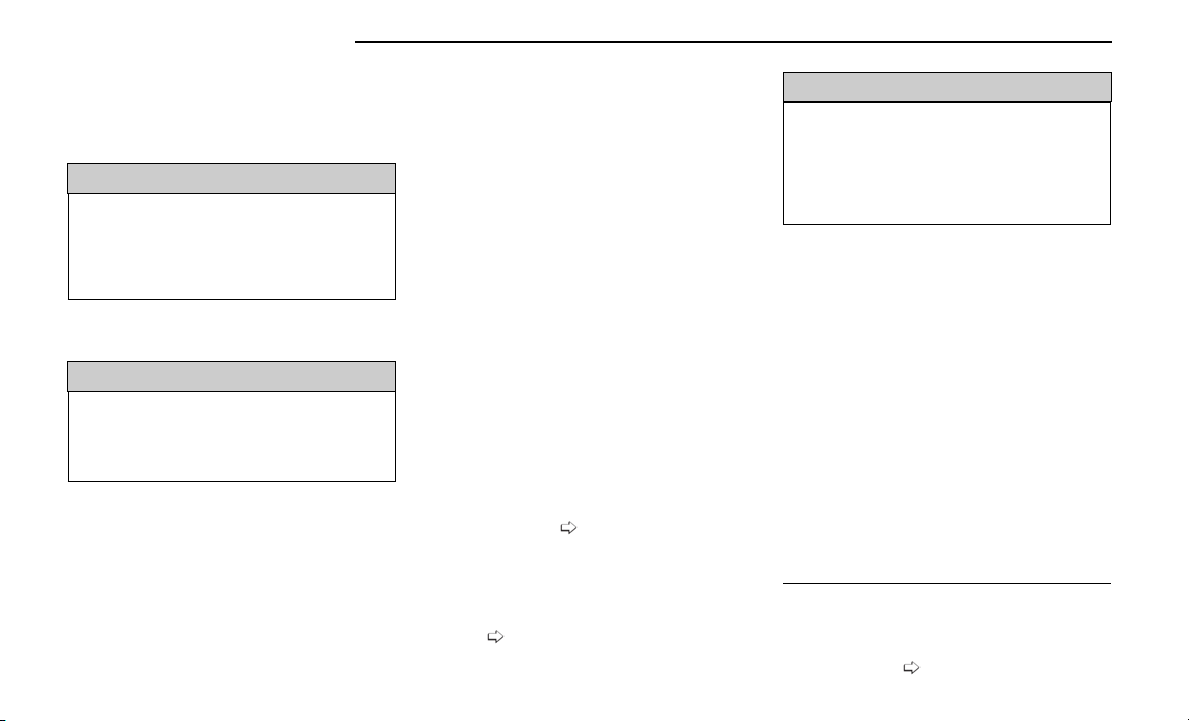Loading ...
Loading ...
Loading ...

very important. Increased tire pressure and reduced
vehicle loading may be required for high-speed vehicle
operation. Refer to an authorized tire dealer or original
equipment vehicle dealer for recommended safe oper-
ating speeds, loading and cold tire inflation pressures.
WARNING!
High speed driving with your vehicle under maximum
load is dangerous. The added strain on your tires
could cause them to fail. You could have a serious
collision. Do not drive a vehicle loaded to the maxi-
mum capacity at continuous speeds above 75 mph
(120 km/h).
Radial Ply Tires
WARNING!
Combining radial ply tires with other types of tires on
your vehicle will cause your vehicle to handle poorly.
The instability could cause a collision. Always use
radial ply tires in sets of four. Never combine them
with other types of tires.
Tire Repair
If your tire becomes damaged, it may be repaired if it
meets the following criteria:
•
The tire has not been driven on when flat.
•
The damage is only on the tread section of your tire
(sidewall damage is not repairable).
•
The puncture is no greater than ¼ of an inch
(6 mm).
Consult an authorized tire dealer for tire repairs and
additional information.
Damaged Run Flat tires, or Run Flat tires that have
experienced a loss of pressure should be replaced
immediately with another Run Flat tire of identical size
and service description (Load Index and Speed Sym-
bol). Replace the tire pressure sensor as well as it is not
designed to be reused.
Run Flat Tires — If Equipped
Run Flat tires allow you the capability to drive 50 miles
(80 km) at 50 mph (80 km/h) after a rapid loss of infla-
tion pressure. This rapid loss of inflation is referred to
as the Run Flat mode. A Run Flat mode occurs when
the tire inflation pressure is at or below 14 psi (96 kPa).
Once a Run Flat tire reaches the Run Flat mode it has
limited driving capabilities and needs to be replaced
immediately. A Run Flat tire is not repairable. When a
Run Flat tire is changed after being driven under a Run
Flat mode 14 psi (96 kPa) condition, please replace the
TPMS sensor as it is not designed to be reused.
NOTE:
TPMS sensor must be replaced after driving the vehicle
on a flat tire condition.
It is not recommended to drive a vehicle loaded at full
capacity or to tow a trailer while a tire is in the Run Flat
mode.
For more information
page 172.
Tire Spinning
When stuck in mud, sand, snow, or ice conditions, do
not spin your vehicle's wheels above 30 mph (48 km/h)
or for longer than 30 seconds continuously without
stopping
page 216.
WARNING!
Fast spinning tires can be dangerous. Forces gener-
ated by excessive wheel speeds may cause tire dam-
age or failure. A tire could explode and injure some-
one. Do not spin your vehicle's wheels faster than
30 mph (48 km/h) for more than 30 seconds con-
tinuously when you are stuck, and do not let anyone
near a spinning wheel, no matter what the speed.
Tread Wear Indicators
Tread wear indicators are in the original equipment
tires to help you in determining when your tires should
be replaced.
These indicators are molded into the bottom of the
tread grooves. They will appear as bands when the
tread depth becomes 1/16 of an inch (1.6 mm). When
the tread is worn to the tread wear indicators, the tire
should be replaced
page 255.
Tire Tread
1 — Tread Wear Indicators
254 SERVICING AND MAINTENANCE
Loading ...
Loading ...
Loading ...